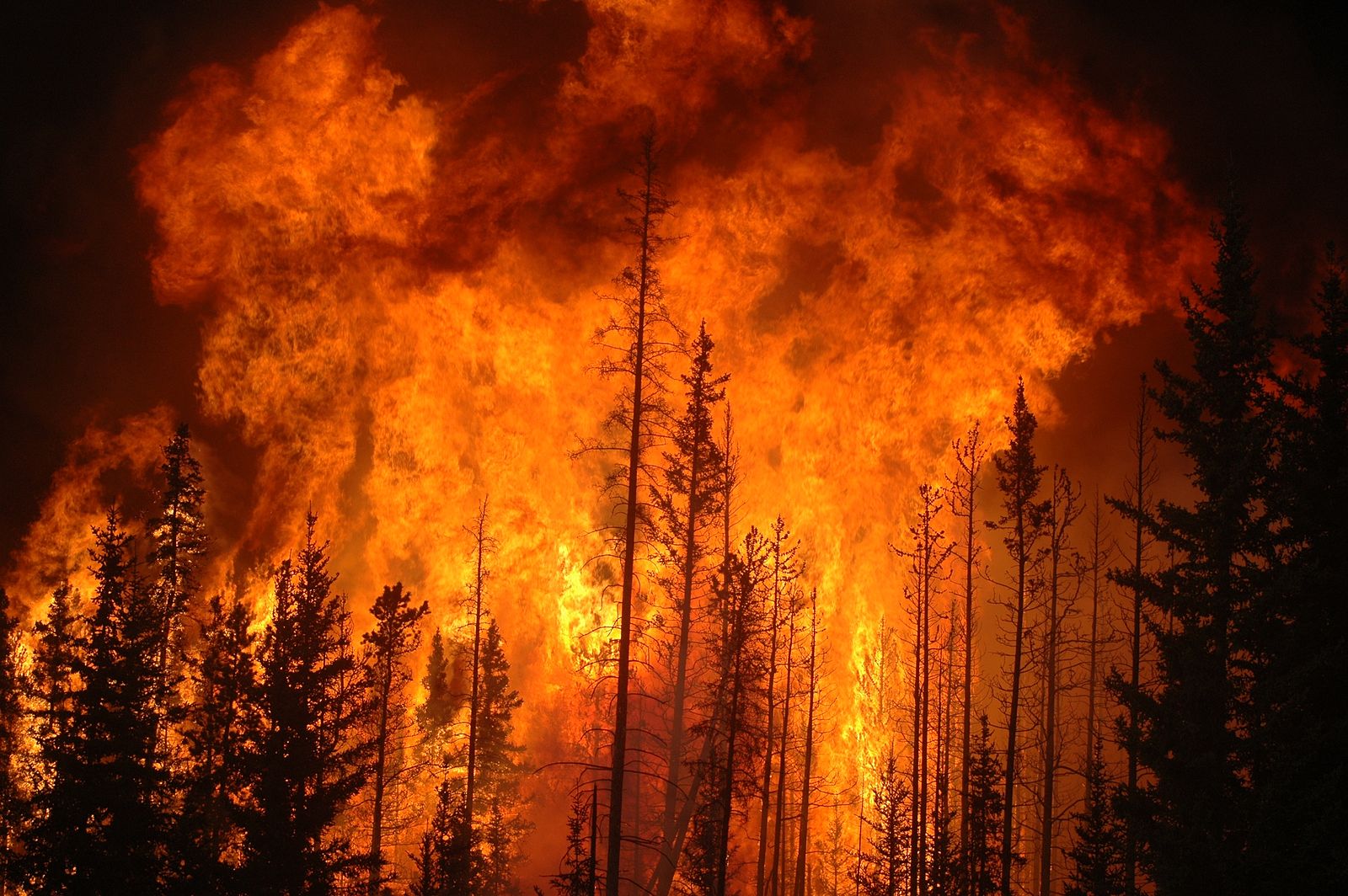Four Climate Security Insights From the COVID-19 Pandemic Response
What insights can be gleaned from the crisis as we prepare for a future increasingly defined by climate destabilization and extreme weather?

Published by The Lawfare Institute
in Cooperation With

What can the U.S. and international coronavirus pandemic response teach us about the climate crisis? At their core, pandemics and climate change are complex, global collective action problems. They are also increasingly conceptualized as nontraditional, novel domestic security threats as well as threats to international peace and security. COVID-19, the respiratory disease caused by the coronavirus, has killed more than 900,000 Americans (to date), a figure far exceeding the total number of all U.S. combat-related deaths in World War II and Vietnam. Climate change, too, threatens lives, a point reinforced by the most recent Intergovernmental Panel on Climate Change (IPCC) report issued this week. And the unfolding Ukraine crisis showcases the dangers of over reliance on fossil fuels from authoritarian petrostates. Witness the devastation wrought by wildfires in the western United States. Climate scientists now warn of a “global wildfire crisis.” And both climate change and the pandemic disproportionately harm the poorest and most vulnerable communities.
As the world enters the third year of the coronavirus pandemic, what insights can be gleaned from the crisis as we prepare for a future increasingly defined by climate destabilization and extreme weather? In what follows, I offer four insights emerging from the response to the coronavirus pandemic.
The Pandemic Response Highlights the Depths of the World’s Carbon Addiction
By one estimate, global greenhouse gas (GHG) emissions plunged 17 percent at the pandemic’s onset. Overall, global GHG emissions dropped approximately 6 percent in 2020—a welcome respite from decades of unabated emissions growth. Economic growth stalled, travel plummeted and consumption decreased dramatically.
Yet this emissions drop proved to be unsustainable as lockdown fatigue kicked in and economies roared back to life. U.S. and global emissions quickly jumped back to pre-pandemic levels in 2021, and emissions are now on pace to grow even more in 2022. Today, GHG levels are at their highest level in human history—a particularly sobering reality as GHG emissions stay in the atmosphere for years, even decades. Meanwhile, climate scientists have called for “transformational action” to address a growing emissions gap. This equates to a 7.6 percent GHG reduction each year this decade just to have a chance of meeting the Paris Agreement’s goal of keeping increases in Earth’s temperatures to less than 1.5 degrees Celsius. Yet despite a pandemic-driven economic slowdown, the world is well off track to meet this goal.
Climate scientists estimate that exceeding this threshold will lead to the “irreversible loss of the most fragile ecosystems, and crisis after crisis for the most vulnerable people and societies.” Indeed, climate impacts will increasingly threaten lives as the global community adapts and responds to climate change. Indeed, due to rising GHG emissions, climate change is already poised to exacerbate extreme weather, droughts, sea level rise and food insecurity this century. This point was reinforced when the U.S. Army released its ambitious 2022 Climate Strategy, a follow-up to the 2021 National Intelligence Estimate on climate change.
The coronavirus pandemic experience highlights the deep, systemic nature of the world’s collective carbon addiction and the climate mitigation challenge ahead. Behavioral changes (less travel, more telecommuting) can certainly assist in temporarily lowering GHG emissions, but long-term progress continues to be a challenge. It remains to be seen if the world is able to scale its collective “mitigation ambition” to meet this challenge.
International Institutions—A Disappointing Pandemic Response Record
The collective failure to reduce GHG emissions will demand even greater climate adaptation efforts. The adaptation challenge is particularly pronounced in developing nations that lack the requisite resources to adapt. Research shows that an effective climate change response will require wealthier, developed nations to assist poorer, developing nations. The coronavirus experience gives reason to be concerned about developed nations’ ability to do this effectively. This has unfolded in two ways.
First, the inequitable coronavirus vaccine distribution effort provides a cautionary tale for future international climate adaptation progress. Internationally, vaccine and personal protective equipment (PPE) distribution have lagged dramatically in the Global South, home to a majority of developing nations. As of this writing, more than 61 percent of the world’s population has received one shot of a coronavirus vaccine, but this proportion plummets to 13 percent for people in low-income countries. Just 10 percent of Africans are fully vaccinated.
Second, key international institutions—including the World Health Organization (WHO) and the U.N. Security Council—failed to build on some of their earlier efforts in the 2014 Ebola global health response. This offers yet another cautionary tale for international institutions’ willingness to address climate security challenges. The Security Council’s comparably muted response to the coronavirus pandemic marked a step backward from the Council’s role in the 2014 Ebola global pandemic when the Security Council determined that the Ebola outbreak in Africa “constitute[d] a threat to international peace and security” within the meaning of Article 39 of the U.N. Charter. Declaring climate change a threat to the peace would unlock international authorities. This could include economic sanctions on nations engaging in harmful climate practices. The Council’s understated role throughout the pandemic response showcases that future Council engagement in addressing nontraditional threats remains far from certain. In December 2021, for example, Ireland and Nigeria co-sponsored a resolution that would have defined climate change a “threat to peace” within the meaning of Article 39. This vote failed, with Russia vetoing the measure.
What are the lessons for climate change? Adaptation efforts are addressed in both the Paris Agreement and the Glasgow Climate Pact. Yet implementation and enforcement of these commitments remain unclear. Not unlike the vaccination effort, climate adaptation progress remains heavily reliant on voluntary financial support and technical assistance from developed nations to developing nations. In light of this, climate negotiators should strengthen transparency and reporting to developing nations and consider legally binding funding commitments. Strengthening reporting requirements should be a focus as the world looks to the next Conference of the Parties in Egypt in 2022.
Climate-Driven Disasters Will Stress and Test the National Guard
As natural disasters increase in scope and scale, the military and the National Guard will be called on to assist state and local responders in emergency response. Within the United States, the U.S.’s coronavirus military response has resulted in one of the largest domestic military deployments in American history. Title 10 federal military forces and state National Guard forces have taken on diverse roles and assignments throughout the pandemic response.
State-based National Guard members have been especially busy. At one point in 2020, 47,000 National Guard members were deployed as part of the pandemic response—a number on par with all service members deployed at that time in Iraq, Afghanistan and Syria. As of this writing, 19,000 members of the National Guard are deployed to combat the coronavirus, taking on a wide range of roles and missions.
Title 10 federal military forces can assist in disaster response via the Defense Support to Civil Authorities mission, but they lack the full spectrum of legal authorities held by each state’s National Guard. Critically, Posse Comitatus Act restrictions do not apply to the National Guard (or Coast Guard), which allows the National Guard and Coast Guard to participate in law enforcement activities if called on to do so. The nation’s experience with Hurricane Katrina and other major disasters showcases that law enforcement assistance cannot be dismissed out of hand.
The National Guard has gradually become the U.S. military’s face of the coronavirus response. Today, National Guard members are serving in hospitals, vaccination sites, even teaching schoolchildren. They are even working at nursing homes and driving school buses. The National Guard’s outsized role throughout the pandemic offers a window into the climate-destabilized future. As climate impacts worsen and intensify, the National Guard will be called on to respond to domestic disaster relief missions. This raises a host of additional questions. For example, is the National Guard properly resourced to address large-scale wildfires and extreme weather events? What is the proper balance between state and federal emergency response?
The Coronavirus Response Offers a New Model for Large-Scale, Domestic Military Deployments
The coronavirus response also offers a new, validated template for domestic military response, highlighting the importance of the National Guard to fill critical staffing roles during times of national emergency. Pentagon leaders predict that climate destabilization will lead to an increased demand signal for the National Guard in firefighting and disaster response in general. Ideally, state and local emergency responders would lead on disaster response, and the military would play a supporting, backup role. Yet the heavy reliance on the National Guard throughout the pandemic demonstrates that states and localities can quickly become overwhelmed during nationwide crises and disasters.
The National Guard is currently deployed under a Title 32, full-time National Guard status—a domestic military model that has been rarely used for disaster response. Traditionally, the National Guard has deployed in domestic disaster response missions under a pure state active-duty status. Here, National Guard members are under state control and funded by the state. Under a Title 32 status, National Guard units remain under the command and control of their respective governors, but they receive continuous federal funds. To date, FEMA has spent $2.7 billion on the National Guard coronavirus mission, which is poised to continue to at least April 2022. This model could serve as a helpful template that could be followed for future, climate-driven disaster response missions.
There are several advantages of this new, Title 32 deployment model.
First, this model ensures local state control (through the governor) and real-time flexibility to be assigned to novel missions and roles as they arise. When the pandemic began, it was unimaginable that National Guard members would teach kindergarten or drive school buses as part of their pandemic response. But that is exactly what Guard members are doing.
Second, an increased role for the military in disaster response raises civil liberties concerns that must be squarely addressed. But reliance on state-controlled National Guard units helps sidestep the weighty historical, legal, and civil liberties concerns long associated with standing armies and federal military forces operating on American soil. Because the National Guard possesses sufficient legal authorities and operates under state governors, there is considerably less pressure or need to invoke the Insurrection Act, an enormously controversial step that places the Guard under federal control.
Third, states often suffer a loss of tax revenue and economic activity in the aftermath of a disaster. This economic devastation was felt by many states and localities throughout the pandemic. The new, Title 32 model ensures a steady stream of federal funding up front, alleviating some of the economic burden. As an added bonus: National Guard members become eligible for federal health care and the GI Bill when their deployment is federally funded—an important retention benefit.
As wildfires and other extreme weather events grow in size and intensity, they will cross state boundaries, thus favoring a more national response and federal coordination. The National Guard may be called on to enforce mandatory evacuation orders in the face of a wildfire or Category 5 hurricane. Or it could involve enforcing a disaster response perimeter in a wildfire’s aftermath to facilitate homeowners’ access to their properties. The Title 32 deployment model offers a new template for federal response to large-scale natural disasters.
Conclusion
The coronavirus pandemic showcases the challenge in addressing complex, collective action problems and the challenge ahead in attempts to avert catastrophic, irreversible harm. But the pandemic response also offers an extraordinary opportunity to gain powerful, actionable insights to plan for the climate-security century. These four insights should help guide policymakers and lawmakers as they confront this challenge.





